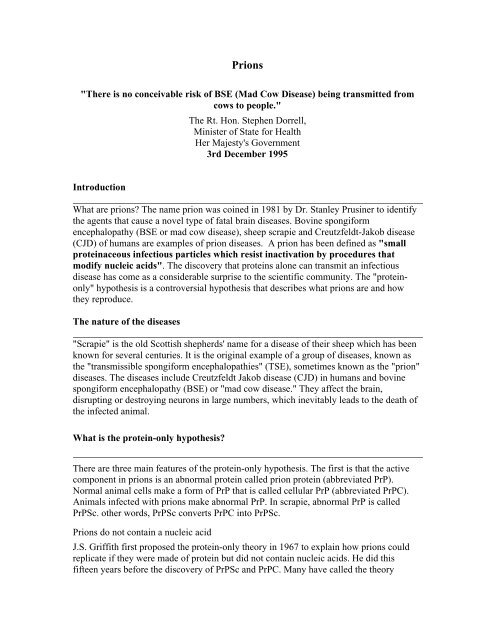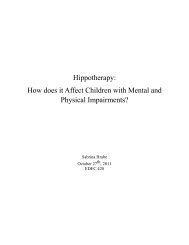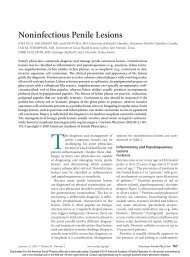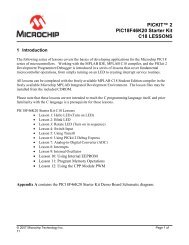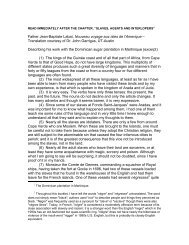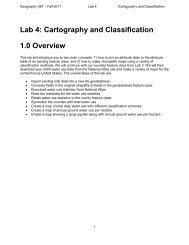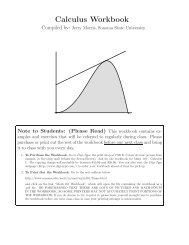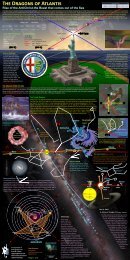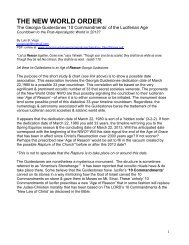Prions - Sonoma State University
Prions - Sonoma State University
Prions - Sonoma State University
Create successful ePaper yourself
Turn your PDF publications into a flip-book with our unique Google optimized e-Paper software.
<strong>Prions</strong><br />
"There is no conceivable risk of BSE (Mad Cow Disease) being transmitted from<br />
cows to people."<br />
The Rt. Hon. Stephen Dorrell,<br />
Minister of <strong>State</strong> for Health<br />
Her Majesty's Government<br />
3rd December 1995<br />
Introduction<br />
What are prions? The name prion was coined in 1981 by Dr. Stanley Prusiner to identify<br />
the agents that cause a novel type of fatal brain diseases. Bovine spongiform<br />
encephalopathy (BSE or mad cow disease), sheep scrapie and Creutzfeldt-Jakob disease<br />
(CJD) of humans are examples of prion diseases. A prion has been defined as "small<br />
proteinaceous infectious particles which resist inactivation by procedures that<br />
modify nucleic acids". The discovery that proteins alone can transmit an infectious<br />
disease has come as a considerable surprise to the scientific community. The "proteinonly"<br />
hypothesis is a controversial hypothesis that describes what prions are and how<br />
they reproduce.<br />
The nature of the diseases<br />
"Scrapie" is the old Scottish shepherds' name for a disease of their sheep which has been<br />
known for several centuries. It is the original example of a group of diseases, known as<br />
the "transmissible spongiform encephalopathies" (TSE), sometimes known as the "prion"<br />
diseases. The diseases include Creutzfeldt Jakob disease (CJD) in humans and bovine<br />
spongiform encephalopathy (BSE) or "mad cow disease." They affect the brain,<br />
disrupting or destroying neurons in large numbers, which inevitably leads to the death of<br />
the infected animal.<br />
What is the protein-only hypothesis?<br />
There are three main features of the protein-only hypothesis. The first is that the active<br />
component in prions is an abnormal protein called prion protein (abbreviated PrP).<br />
Normal animal cells make a form of PrP that is called cellular PrP (abbreviated PrPC).<br />
Animals infected with prions make abnormal PrP. In scrapie, abnormal PrP is called<br />
PrPSc. other words, PrPSc converts PrPC into PrPSc.<br />
<strong>Prions</strong> do not contain a nucleic acid<br />
J.S. Griffith first proposed the protein-only theory in 1967 to explain how prions could<br />
replicate if they were made of protein but did not contain nucleic acids. He did this<br />
fifteen years before the discovery of PrPSc and PrPC. Many have called the theory
heretical because it describes replication of a pathogenic agent without a nucleic acid<br />
genome. (Genes are made of nucleic acids. The nucleic acids store and transmit genetic<br />
information in all known organisms.) In fact, the hypothesis is based upon known<br />
properties of proteins with the added wrinkle that a protein molecule folded in an<br />
abnormal way can alter the folding of another protein molecule and thereby change its<br />
biological properties. To quote from J.S. Griffith's 1967 paper, "the occurrence of a<br />
protein agent would not necessarily be embarrassing although it would be most<br />
interesting."<br />
In many respects the diseases are unusual. For example there is a long period, the<br />
incubation period, after an animal is infected before signs of the disease can be detected.<br />
The incubation period is controlled by a gene of the infected animal which makes a<br />
protein called PrP. There is no apparent reaction to infection in the animal - no immune<br />
response. And most notably, the cause of the disease, the "infective agent" has unusual<br />
properties. These unusual properties have prompted much speculation and debate about<br />
what the "infective agent" is, and how it works. Despite its unusual properties, is it like<br />
other infectious particles, (i.e. viruses), is it a bit different from other infectious agents, or<br />
is it completely different from any other infectious particle, even perhaps have biological<br />
properties which have never been described before? This question has been debated for<br />
three decades and still has not been resolved.<br />
The debate revolves around two issues: Firstly, is a nucleic acid (DNA or RNA) a part of<br />
the agent which determines what the agent does. If there is one, why can we not find it? If<br />
there is no nucleic acid, how are agent properties specified? Secondly, PrP (sometimes<br />
called prion protein) , is associated with the agent somehow - but what does it do? This<br />
debate matters because no life form, including any virus, has been found which does not<br />
have nucleic acid as the molecule which encodes the chemical information for its<br />
existence. There is no model which we can use to compare the T.S.E. agent, if it does not<br />
have a nucleic acid.<br />
Do "prions" exist? The word "prion" is used in different ways. It is used to describe the<br />
TSE group of diseases but it is also associated with the "protein-only" hypothesis<br />
discussed below. I find it helpful not to use the word prion to describe the diseases, to<br />
avoid confusion with the hypothesis. The word is also used to describe the infective agent<br />
and I think nowadays it is generally accepted that by "prion" scientists mean a PrPprotein-only<br />
agent, without nucleic acid or other molecule encoding the agent's<br />
information. Until we know better what the structure of the agent is and whether it has a<br />
nucleic acid or not, I find it helpful to use the word "agent". Until a nucleic acid is found<br />
or a mechanism for protein-only replication demonstrated, prion is most usefully used to<br />
describe the protein-only hypothesis.<br />
Supporting evidence<br />
The prion protein (PrPSc) fulfills all the necessary criteria to be the active component of<br />
the infectious particle. First, infectious prions isolated from brain tissue contain PrPSc. A<br />
process called purification removes molecules that are not part of the prion. The purity of<br />
a prion preparation is judged by how much infectivity is present for each gram of protein
or nucleic acid. PrPSc is the only protein found in the best-purified preparations.<br />
Scientists have looked in these preparations for specific nucleic acids (e.g., virus genes)<br />
but have not found one despite searching for more than 30 years. Thus, the only molecule<br />
identified in the infectious particle is PrPSc. PrPSc is involved in all known prion<br />
diseases. In some cases, PrPSc molecules have a normal sequence but an abnormal<br />
conformation. In other cases, a change in the PrP gene sequence (mutation) causes PrP to<br />
fold incorrectly.<br />
All mammals appear to have prion protein genes and the gene sequences are similar, but<br />
not identical, in related species. Differences in the PrP amino acid sequence play an<br />
important role in determining whether prions from one species can infect hosts of another<br />
species. This behavior is difficult to explain if prions are not made of prion protein.<br />
PrPSc molecules can bind to PrPC molecules in the test tube and convert them to the<br />
abnormal (PrPSc) conformation. The sequences of the PrPSc and PrPC molecules must<br />
be similar for the conversion to work, and thus the behavior of the PrP molecules in the<br />
test tube parallels the behavior of prions in nature.<br />
Sometimes prions from different cases of prion disease vary in the way they affect the<br />
brain, giving rise to different prion strains. The variation in strain behavior correlates<br />
with differences in the conformation of their PrP molecules. <strong>Prions</strong> isolated from certain<br />
new cases of CJD in the United Kingdom that are thought to be caused by BSE prions<br />
show unique strain characteristics. Those prions have a PrP conformation that is similar<br />
to that of the PrP molecule from BSE prions, but different from that in conventional CJD<br />
prions or scrapie prions.<br />
Conclusion<br />
The protein-only hypothesis remains controversial because it breaks new conceptual<br />
ground. Those who have worked in this field under other paradigms (like the virus or<br />
virino hypotheses) are reluctant to accept this new paradigm. Scientists from other fields<br />
are more receptive to this hypothesis, however, and thus it has gained broad support. This<br />
hypothesis best explains all of the observations about these agents and the diseases they<br />
cause. If at some point it fails to do so, the hypothesis will need to be revised or rejected<br />
in favor of a better hypothesis. That is the nature of science.
Creutzfeldt-Jakob disease (CJD)<br />
In 1920, two Austrian doctors called H.G.Creutzfeldt and A.Jakob first described a<br />
disease which in many respects is similar to Alzheimer's disease:<br />
Looking at the victims brains under the microscope, they saw that many of the normal<br />
brain cells had died, causing the development of many tiny holes, too small to be seen by<br />
the naked eye, and a mesh of fine fibres. The appearance of the brain tissue resembled a<br />
microscopic sponge, and the expression "spongiform encephalopathy" was used to<br />
describe the disease. At first, suffers of Creutzfeldt-Jakob disease (CJD) are usually<br />
unaware that anything is wrong. Often there are subtle symptoms such as lapses of<br />
memory for daily events, and sometimes mood changes. Increasing apathy and loss of<br />
interest in normal daily and social activities is common. At this point, straightforward<br />
tasks that were previously simple become progressively more difficult for the sufferer.<br />
Early in the disease, the illness is frequently disregarded by friends, relatives and the<br />
sufferers themselves as the results of stress, being 'run down' or as mild depression\<br />
Within weeks of the onset of the disease, other less easily discounted symptoms begin to<br />
appear. Neurological signs such as loss of balance, hesitancy in walking, deteriorating<br />
vision (sometimes including terrifying hallucinations), slurring and slowing of speech are<br />
common. After this, sufferers decline rapidly, becoming incontinent and experiencing<br />
involuntary, jerky movements of the limbs (known as myoclonus). Most patients slip into<br />
a comatose state without the ability to speak or move. Fortunately, the very apathy and<br />
loss of mental functions which CJD causes seems to protect victims from awareness of<br />
their fate. People affected by CJD usually die within 6 months of the onset of the disease.<br />
Only in 10% of cases does the disease run a more prolonged course of, for example, 2-5<br />
years.<br />
There is no known cure for CJD nor is there any treatment which can halt the progress of<br />
the disease.<br />
References – information above taken from the following sources<br />
http://www-micro.msb.le.ac.uk/Tutorials/cow/cow1.html<br />
http://www.pbs.org/wgbh/nova/madcow/prions.html


